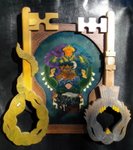I spend so much time looking at or thinking of things that are pretty or at least interesting in a pleasant way, that sometimes I need to paint something from the darker side of life. Maybe that is why this old, so old in fact that nobody knows who wrote it, verse was written in the first place. Or perhaps it was a warning to those people who might live a life uninterested in how they make others feel. Folklore often has a 'boogie man' sort of warning to it.
When I first came across this it was sung, and the tune deceptively jolly. In fact it was some time before I realized just what the song was about. Later I found it in many forms and always I formed a visual, which I do for most things I hear or read.
So what follows is the verse, which I left in the misspelled Celtic to give you the flavor of having it read in such. I think most people will understand anyway. The painting that follows a 16 x 20 acrylic on canvas, containing a sky that my daughter filmed and the happy characters of the verse; who's fortune comes form another's tragic ending. But that is nature cruel and kind in turns. (Picture a conversation between the two birds.)
Twa Corbies
As I was walking all alane, I heard twa corbies mock and mane;
and to one the other did say, "whaur shall we gang and dine the day?"
"In behind the old failed dike, I know what lies on slain the night;
nobody kens that he lies there but his hawk and hound and his lady fair."
"His hawk is to the hunting gone, His hound to bring the wild fowl'en;
his wife has taken another mate, so we can mark our dinner sweet."
"Ye'll sit on his white breast bane, and I'll pick oot his bonny blue'en."
"Wi'ae lock o' his yellow hair we'll theek our nest when the wind grows bare."
For manys a one that mocks his name, nobody cares that he is gane;
an'through his white bones when they grow bare, the wind shall blow for evermare.
Sunday, March 12, 2006
Subscribe to:
Post Comments (Atom)



No comments:
Post a Comment